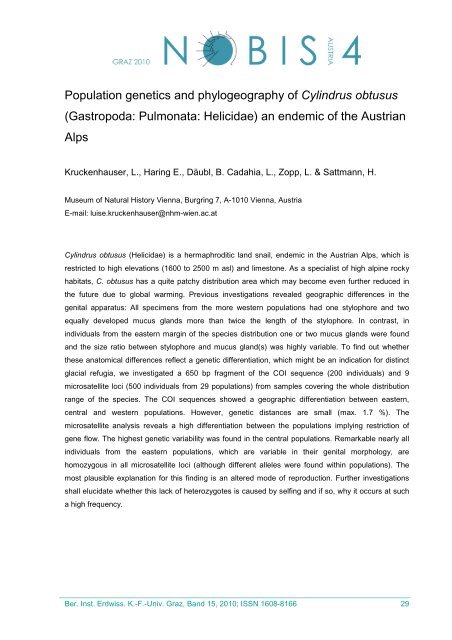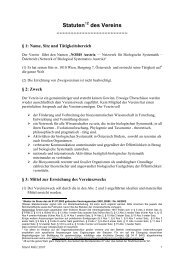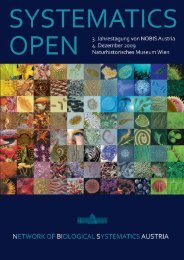4. Jahrestagung von NOBIS Austria 2. - 3. Dezember 2010
4. Jahrestagung von NOBIS Austria 2. - 3. Dezember 2010
4. Jahrestagung von NOBIS Austria 2. - 3. Dezember 2010
You also want an ePaper? Increase the reach of your titles
YUMPU automatically turns print PDFs into web optimized ePapers that Google loves.
Population genetics and phylogeography of Cylindrus obtusus<br />
(Gastropoda: Pulmonata: Helicidae) an endemic of the <strong>Austria</strong>n<br />
Alps<br />
Kruckenhauser, L., Haring E., Däubl, B. Cadahia, L., Zopp, L. & Sattmann, H.<br />
Museum of Natural History Vienna, Burgring 7, A-1010 Vienna, <strong>Austria</strong><br />
E-mail: luise.kruckenhauser@nhm-wien.ac.at<br />
Cylindrus obtusus (Helicidae) is a hermaphroditic land snail, endemic in the <strong>Austria</strong>n Alps, which is<br />
restricted to high elevations (1600 to 2500 m asl) and limestone. As a specialist of high alpine rocky<br />
habitats, C. obtusus has a quite patchy distribution area which may become even further reduced in<br />
the future due to global warming. Previous investigations revealed geographic differences in the<br />
genital apparatus: All specimens from the more western populations had one stylophore and two<br />
equally developed mucus glands more than twice the length of the stylophore. In contrast, in<br />
individuals from the eastern margin of the species distribution one or two mucus glands were found<br />
and the size ratio between stylophore and mucus gland(s) was highly variable. To find out whether<br />
these anatomical differences reflect a genetic differentiation, which might be an indication for distinct<br />
glacial refugia, we investigated a 650 bp fragment of the COI sequence (200 individuals) and 9<br />
microsatellite loci (500 individuals from 29 populations) from samples covering the whole distribution<br />
range of the species. The COI sequences showed a geographic differentiation between eastern,<br />
central and western populations. However, genetic distances are small (max. 1.7 %). The<br />
microsatellite analysis reveals a high differentiation between the populations implying restriction of<br />
gene flow. The highest genetic variability was found in the central populations. Remarkable nearly all<br />
individuals from the eastern populations, which are variable in their genital morphology, are<br />
homozygous in all microsatellite loci (although different alleles were found within populations). The<br />
most plausible explanation for this finding is an altered mode of reproduction. Further investigations<br />
shall elucidate whether this lack of heterozygotes is caused by selfing and if so, why it occurs at such<br />
a high frequency.<br />
_____________________________________________________________________________<br />
Ber. Inst. Erdwiss. K.-F.-Univ. Graz, Band 15, <strong>2010</strong>; ISSN 1608-8166 29






